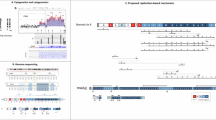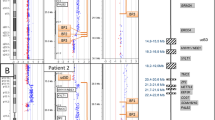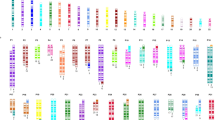Abstract
We report on two patients with duplication of the subterminal region of chromosome 16p (dup16p) recognized by fluorescent in situ hybridization (FISH) telomere analysis, presenting with closely overlapping facial features and neurological impairment. Distinct facial anomalies included high forehead, sparse eyebrows, blepharophimosis, short nose, everted upper lip, high-arched palate, wide-spaced teeth, and cupped anteverted ears. Susceptibility to vascular anomalies, in particular pulmonary hypertension and portal cavernoma, was found in one patient. Subtelomeric analysis by FISH demonstrated a de novo duplication of the subtelomeric region of chromosome 16p and a deletion of the subtelomeric region of chromosome 4q in case 1, and duplication of the subtelomeric region of 16p and a deletion of the subtelomeric region of 21q, resulting from malsegregation of a balanced maternal traslocation t(16pter;21qter) in case 2. The extension of duplicated regions measured by array-comparative genome hybridization was about 12 Mb on 16p13.3p13.13 in case 1, and about 8.5 Mb on 16p13.3p13.2 in case 2. In conclusion, we reported a clinically recognizable disorder in two patients with dup16p. Pulmonary hypertension, vascular ring, and manifestations of vascular disruption, as terminal hypoplasia of hands and aplasia cutis, have been previously described in association with dup16p. Thus, susceptibility to pulmonary vascular disease and other vascular anomalies can be a feature of dup16p, suggesting that this subtelomeric region in some respect could be related to vascular anomalies.
Similar content being viewed by others
Log in or create a free account to read this content
Gain free access to this article, as well as selected content from this journal and more on nature.com
or
References
Leonard C, Huret JL, Imbert MC, Lebouc Y, Selva J, Boulley AM : Trisomy 16p in a liveborn offspring due to maternal translocation t(16;21)(q11;p11) and review of the literature. Am J Med Genet 1992; 43: 621–625.
O'Connor TA, Higgins RR : Trisomy 16p in a liveborn infant and review of trisomy 16p. Am J Med Genet 1992; 42: 316–319.
Schinzel A, Kotzot D, Brecevic L et al: Trisomy first, translocation second, umiparental disomy and partial trisomy third: a new mechanism for complex chromosomal aneuploidy. Eur J Hum Genet 1997; 5: 308–314.
Juan JLC, Cigudosa JC, Gomez AO, Almeida MTA, Miranda LG : De novo trisomy 16p. Am J Med Genet 1997; 68: 219–221.
Movahhedian HR, Kashani DS, Bull D, Jones KL, Rothman A : Pulmonary hypertension and trisomy 16. Pediatr Cardiol 1998; 19: 187–189.
Kokalj-Vokac N, Medica I, Zagorac A, Zagradisnik B, Erjavec A, Gregoric A : A case insertional translocation resulting in partial trisomy 16p. Ann Genet 2000; 43: 131–135.
Tschernigg M, Petek E, Leonhardtsberger A, Wagner K, Kroisel PM : Terminal tandem duplication of 16p: a case with ‘pure’ partial trisomy (16)(pter → p13). Genet Couns 2002; 13: 303–307.
Martin CL, Waggoner DJ, Wong A et al: ‘Molecular rulers’ for calibrating phenotypic effects of telomere imbalance. J Med Genet 2002; 39: 734–740.
Sommer A, Pastore M, Wenger G : Trisomy 16p: a longitudinal profile and photo essay. Am J Med Genet 2006; 140A: 174–179.
De Ravel T, Aerssens P, Vermeesch JR, Fryns JP : Trisomy of chromosome 16p13.3 e to an unbalanced insertional translocation into chromosome 22q13. Eur J Med Genet 2005; 48: 355–359.
Ruiter EM, Koolen DA, Kleefstra T et al: Pure subtelomeric microduplications as a cause of mental retardation. Clin Genet 2007; 72: 362–368.
Bernardini L, Palka C, Ceccarini C et al: Complex rearrangement of chromosomes 7q21.13-q22.1 confirms the ectrodactyly-deafness locus and suggests new candidate genes. Am J Med Genet A 2008; 146A: 238–244.
Leschot NJ, Denef JJ, Geraedts JPM et al: Five familial cases with a trisomy 16p syndrome due to translocation. Clin Genet 1979; 16: 205–214.
Ohdo S, Madokoro H, Sonoda T, Hayakawa K : Mental retardation associated with congenital heart disease, blepharophimosis, blepharoptosis, and hypoplastic teeth. J Med Genet 1986; 23: 242–244.
Rochat MK, Riegel M, Schinzel AA : Long-term follow-up of a 26-year-old male with duplication of 16p: clinical report and review. Am J Med Genet 2007; 143A: 399–408.
Marangi G, Leuzzi V, Orteschi D et al: Duplication of the Rubinstein-Taybi region on 16p13.3 is associated with a distintive phenotype. Am J Med Genet 2008; 146A: 2313–2317.
Acknowledgements
We thank Dr Annemarie Sommer from the Ohio State University and Children's Hospital, Columbus, Ohio, and the parents of the patient for providing us Figure 2.
Author information
Authors and Affiliations
Corresponding author
Rights and permissions
About this article
Cite this article
Digilio, M., Bernardini, L., Capalbo, A. et al. 16p subtelomeric duplication: a clinically recognizable syndrome. Eur J Hum Genet 17, 1135–1140 (2009). https://doi.org/10.1038/ejhg.2009.14
Received:
Revised:
Accepted:
Published:
Issue date:
DOI: https://doi.org/10.1038/ejhg.2009.14
Keywords
This article is cited by
-
Complex small supernumerary marker chromosome with a 15q/16p duplication: clinical implications
Molecular Cytogenetics (2014)



